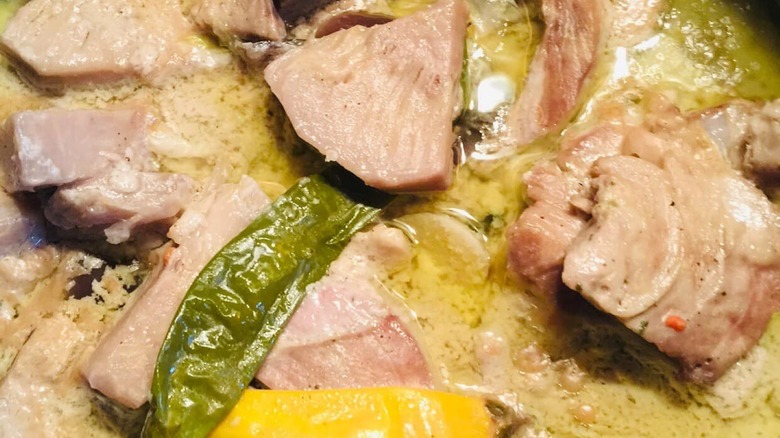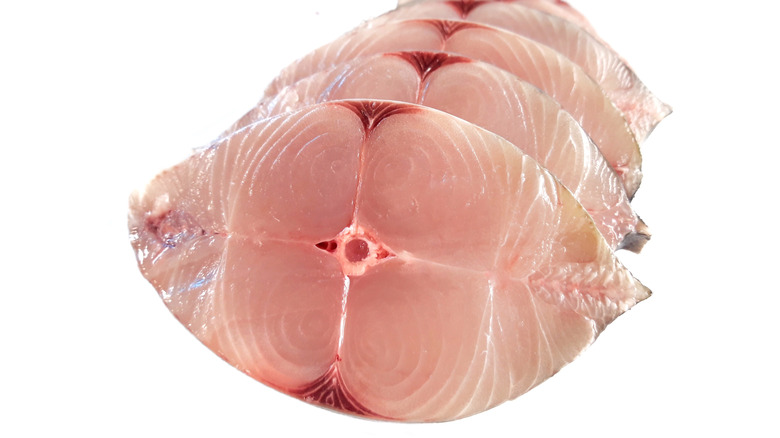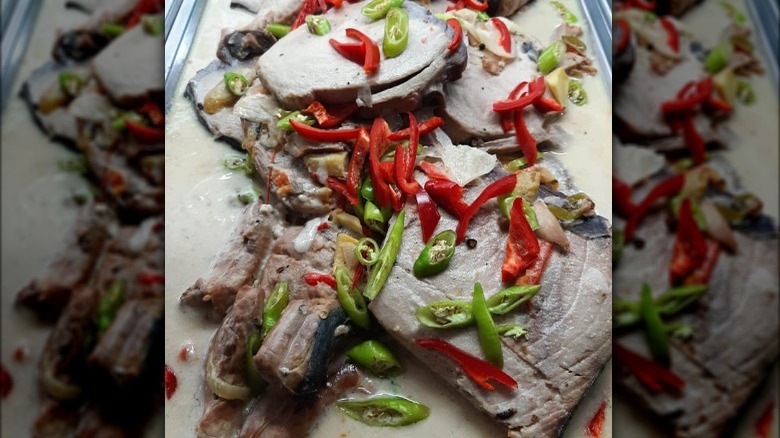Ginataang Tuna: The Saucy Filipino Fish Dish With A Kick
Filipino food, like many cuisines, evolved as a result of its surroundings. Because it is a group of islands in the tropics, its food had to be prepared so that it wouldn't become immediately spoiled. The country's rich history includes exposure to traders from China, the Malay Peninsula in Thailand, and it was a Spanish colony for hundreds of years, so its cooking saw plenty of Central and South American influences, per CNBC. And since the country is made up of 7,100 islands and 22 regions, there are countless regional varieties of popular dishes. Fun fact: Crown Asia says there are over 100 different ways to make adobo, the country's "unofficial national dish."
The Philippines' geography can also explain the country's love of seafood. Per Dumaguete Info, the country's prime position within the coral triangle has made it easy for fishermen to lean on seafood as a source of protein. Consequently, many of the country's dishes showcase some kind of seafood, be it fish, prawn, oysters, squid, or mussels which can be grilled, fried, steamed, pickled, or marinated, per Taste Atlas. One especially popular seafood dish is a one-pot wonder: ginataang tuna.
Origins of ginataang tuna
Ginataang tuna is literally "tuna cooked in gata" or tuna cooked in coconut milk. Ang Sarap describes that the dish, which is also known as "ginataang tulingan," is prepared with a medley of vegetables as well as chilies to give the dish a signature kick. The site adds that the presence of coconut milk, chilies, and skipjack tuna all point to the dish's origin in the Bicol region, which is located on the southernmost tip of Northern Philippines' Luzon island.
No stories exist — at least online — that reveal the origins of ginataang tuna, but the style of cooking with coconut milk or "gata" is especially common in that part of the Philippines, where the coconut is also its biggest crop, per the Philippine Government. Chilies, also known as "sili" in the local dialect, are equally important to cooks from that part of the country, so much so that in his book "The Coconut Cookery of Bicol," author Honesto General pokes fun at the locals, saying "In the face of an oncoming typhoon (which Bicol gets hit with several times a year), the Bicolano will prop up his sili bush before his nipa hut [house]," per Natasha Alli. So, it's no surprise that this region chooses to cook fish this way.
Ingredients and variations
Tuna ginataang is a relatively simple recipe where the fish is sauteed with aromatics (garlic, onion, chilies, turmeric, ginger) and then stewed in coconut milk. Apart from the staple ingredients we just listed, different cooks are likely to add different things when they make this one-pot dish. Ang Sarap recommends preparing eggplant, bok choy, and moringa leaves, while Panlasang Pinoy recommends tomatoes along with the eggplant, as well as Philippine limes or calamansi for a sour kick. Isla Kulinarya does away with the tomato and slips in a cup of string beans in its place.
The vegetables you choose aren't the only add-ins that set this recipe apart. The type of coconut milk used in the recipe determines how creamy the dish eventually becomes. Pinoy Food Guide says "gata" or coconut milk is usually added at the beginning, while "kakang gata" or coconut cream is added to finish — and that usually determines how creamy your dish is likely to be. Isla Kulinarya recommends using coconut milk and boiling it before adding the fish and vegetables. Ang Sarap recommends blending both coconut milk and coconut cream, then adding it to the mix until the sauce gets thick.
And as anyone from the Philippines might tell you — ginataang tuna served with a side of piping hot rice is as close to tropical island paradise on a plate as it gets.


